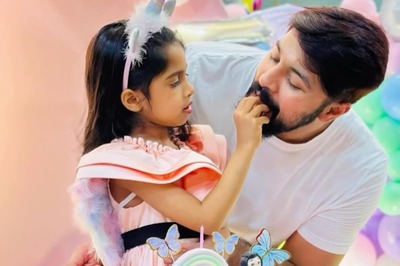
views
As children grow older, they become more independent and responsible for their personal hygiene. It becomes increasingly important to teach them about advanced hygiene practices, including those related to toilet hygiene. While basic habits like washing hands after using the restroom are well-established, introducing advanced practices can lead to a more holistic approach to personal hygiene.
This is where parents, too, need to challenge their own toilet habits. Many of us grew up in cultures where practices were different, and just because we grew up doing things one way, doesn’t make it the ‘best’ way forward. If that were so, we wouldn’t have needed the Swachh Bharat Mission.
What are advanced toilet hygiene practices?
Advanced toilet hygiene practices are methods of cleaning and caring for the genital and anal areas after using the toilet. They include:
Using bidets: Bidets are devices that spray water to wash the intimate area. They can be attached to the toilet seat, or be standalone fixtures. Bidets can provide a more thorough and gentle cleaning than toilet paper, reducing irritation, itching, and odour. They can also help prevent urinary tract infections, haemorrhoids, and anal fissures.
Using eco-friendly products: Eco-friendly products are alternatives to conventional toilet paper that are made from natural or recycled materials, such as bamboo, cotton, or hemp. They are biodegradable, compostable, and do not contain harmful chemicals or dyes. Eco-friendly products can help reduce deforestation, water consumption, and greenhouse gas emissions caused by the production of toilet paper. They can also be softer and more gentle on the skin than regular toilet paper.
Proper menstrual hygiene: Proper menstrual hygiene is the practice of using safe and hygienic products to manage menstrual bleeding, such as pads, tampons, cups, or period underwear. It also involves changing the products regularly, washing the intimate area with mild soap and water, and disposing of the products properly. Proper menstrual hygiene can help prevent infections, rashes, odours, and leaks. It can also help girls feel more confident and comfortable during their periods.
Why are advanced toilet hygiene practices important?
Advanced toilet hygiene practices are important for several reasons:
They can improve children’s health and well-being: by helping children keep their intimate area clean and healthy, preventing infections and diseases that can affect their urinary and reproductive systems. Moreover, they help children avoid discomfort, irritation, and embarrassment caused by poor hygiene.
They can foster children’s self-esteem and autonomy: by helping children sidestep shame and develop a positive attitude towards their bodies and their sexuality. They can also help children gain more control and confidence over their personal hygiene, preparing them for puberty and adulthood.
They can promote environmental awareness and responsibility: by helping children learn about the environmental impact of their choices and actions and adopt more sustainable habits that can reduce their ecological footprint.
How to introduce advanced toilet hygiene practices to your children?
Introducing advanced toilet hygiene practices to your children may seem challenging or awkward at first, but it does not have to be. Here are some tips to make it easier:
Start early: The best time to introduce advanced toilet hygiene practices to your children is when they are still young and curious about their bodies. You can start by explaining the basic functions and parts of their genital and anal areas, using simple and age-appropriate language. You can also show them how to use the toilet properly, how to wipe themselves with toilet paper or wet wipes, and how to wash their hands afterwards.
Be open and honest: As your children grow older, they may have more questions or concerns about their intimate hygiene. You should be ready to answer them honestly and respectfully, without shaming or judging them. Work to create an atmosphere where they feel comfortable asking you anything they want to know, without shame or embarrassment about their bodies or their hygiene.
Lead by example: One of the best ways to teach your children advanced toilet hygiene practices is to model them yourself. You can show them how you use bidets or eco-friendly products in your own bathroom, explaining why you prefer them over regular toilet paper. Mothers can share their own experiences with menstrual hygiene, showing them the products they use and how they manage their periods.
Provide options and guidance: When introducing advanced toilet hygiene practices to your children, give them options and let them choose what they feel comfortable with. Provide guidance on how to use the products safely and effectively, such as how to adjust the water pressure of the bidet, how to insert a tampon or a cup, or how to wash a reusable pad or underwear.
Be supportive and respectful: Introducing advanced toilet hygiene practices to your children may involve some trial and error, as they may need some time to get used to them or find what works best for them. Be supportive and respectful of their choices and preferences, respect their privacy and boundaries, be available for questions and discussions, and praise often.
Talking about Toilet Hygiene With Confidence
Most of us grew up with the injunction that it was rude to talk about the toilet. We understand the need to talk about toilets, toilet access and toilet hygiene, but it is hard to break that conditioning – it still feels weird to talk about.
One way to counter that awkwardness is through educating oneself, and framing the larger context. Harpic, India’s leading brand in the lavatory care segment, understands this. Harpic and News18 came together in Mission Swachhta aur Paani, a movement that has, for 3 years now, championed the cause of inclusive sanitation, equality for all genders, abilities, castes and classes and the strong belief that clean toilets are a shared responsibility.
Mission Swachhta aur Paani serves as a platform where stakeholders across government, NGOs, activists, doctors, user groups and many more can come together and talk about the issues and nuances of toilet access and toilet hygiene in India. By having these conversations, and by getting the word out, Harpic and News18 aim to both educate and engage with a larger audience. Mission Swachhta aur Paani also serves to empower parents and educators with information on a wide range of topics related to toilet access and hygiene.
We need to have these conversations – amongst ourselves, with our children, with our own parents and elders. Conversations lead to discovery, to shine the light into our prejudices and misconceptions, to nuanced understanding and knowledge, and to empathy.
Let’s talk about it, and play our part in creating a Swachh and Swasth Bharat.


















Comments
0 comment